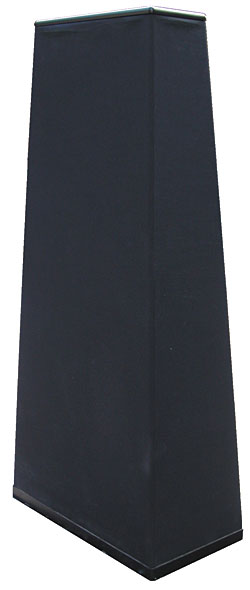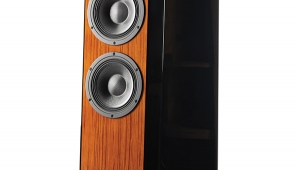| Columns Retired Columns & Blogs |
Vandersteen Audio Quatro loudspeaker
Record playback could have been designed to go from the inside out instead of the other way around. With most pieces of music ending louder than they started, doesn't it make more sense to end the side at the widest circumference, longest wavelength, least congested part of the groove spiral? Compact discs read from the center hole out, and they don't even have to.
 Life, too, would be better if it ran that way. You'd begin existence old and feeble, knowing everything, and just get younger. You'd still wind up near the end crawling on all fours, gurgling and eating baby food, but soon thereafter...what a way to go!
Life, too, would be better if it ran that way. You'd begin existence old and feeble, knowing everything, and just get younger. You'd still wind up near the end crawling on all fours, gurgling and eating baby food, but soon thereafter...what a way to go!
Audio reviewing would be much more accurate if one got to hear everything before reviewing anything. Unfortunately, it doesn't work that way.
Because Vandersteen Audio has been around for so long, because it doesn't reinvent itself for marketing purposes every six months, and because, while the speakers it builds are attractive enough, they don't exactly qualify as eye candy, the brand is sometimes taken for granted. Richard Vandersteen's loudspeakers uniformly get respect, but they're rarely the objects of audio lust. I've been doing this for 20 years and somehow, until now, I'd never reviewed a pair. My bad.
I first heard Vandersteen's new Quatro at last year's CEDIA Expo home theater extravaganza in (of all places) Indianapolis, Indiana, during a visit to the Audio Research room. The Quatro is a small, graceful, tapered box less than 4' tall, with a footprint of 10" by 19". As is typical of Vandersteen designs, the baffle is wrapped in black cloth, which cuts both costs and visual appeal. (A more attractive, all-wood version, the Quatro Wood, was recently introduced; prices start at $10,700/pair.) On the other hand, if you want a speaker that can seem to disappear in a room, the cloth-covered Quatro fits the bill.
Yet despite the Quatro's bland looks, there was something so right—tonally, spatially, and dynamically—about the sound I heard that day in the Audio Research room that I blurted out right on the spot that I'd like to review them. That's the first time at a trade show that a Vandersteen speaker has elicited such a response from me.
The man comes around
Six months later, Richard Vandersteen arrived at my door to set up the Quatros, the unsettled spring weather having convinced him to fly via commercial airliner instead of piloting his own plane. After a short session of listening to my reference speakers, the Wilson Audio Specialties MAXX2s, we rolled the Wilsons out of the way, unboxed the Quatros, and placed them within the lines of masking tape that define where the MAXX2s—and most other speakers I've reviewed here—sound best.
The Quatro is a four-way design with a subwoofer system comprising two 8", long-throw, carbon-loaded cellulose cones powered by a 250W class-B amplifier. The sub's 20–100Hz bass response is room-customizable via an 11-band low-frequency equalizer as well as level and contour controls. The idea is to place the speakers where the imaging and soundstaging are best, then dial in the optimal bass afterward.
All of the Quatro's crossovers are first order (6dB/octave), which Vandersteen says maintains time and phase coherence. But because of the shallowness of the rolloff slopes, such designs require drivers of the highest quality, capable of linear performance over a wide bandwidth.
A newly designed 6.5" woven-fiber cone unit produces midbass and lower-midrange frequencies (100–900Hz); Vandersteen's patented drive-unit design, a transmission-line–loaded, curvilinear, mineral-filled polycone unit handles the upper midrange and the low treble (900Hz–5kHz). Richard Vandersteen explained that the design of this unit eliminates backwave reflections caused by its magnet structure, which can smear transients and diffuse images. A tapered, transmission-line–loaded dome tweeter of ceramic-coated aluminum alloy handles the high frequencies, from 5kHz to beyond 30kHz.
Setup began with the insertion of the passive high-pass filter boxes between preamp and amp. These cost $595/pair for unbalanced operation, $795/pair for balanced, and while they are priced separately, they must be used with the Quatro to provide the necessary bass rolloff for the passive woofer. Its first-order filter action, –3dB at 100Hz referenced to 1kHz, is set by matching its impedance via internal DIP switches to the amplifier's input impedance.
The amplifier's output (with its bass rolled off) feeds two pairs of screw-terminal barrier strips mounted on the Quatro's rear panel: one for bass/midbass, one for midrange/tweeter. Richard Vandersteen recommends true biwiring, using two separate runs from each amplifier (or channel of a stereo amplifier) to each speaker. He claims that old-fashioned barrier strips sound best, but because of their narrowness, many modern spade lugs will be too wide to fit them. That proved to be the case with all the cables I had on hand—enough to build a suspension bridge. Fortunately, he'd brought along biwire sets of AudioQuest Volcano speaker cable (AQ also makes the filter box's output cable) fitted with sufficiently narrow spades to fit the Quatro's strips.
The powered subwoofer takes its input from the speaker terminals, with an inverse first-order filter restoring flat response. This allows your power amplifier's sonic character to determine the final sound of both the powered woofer module below 100Hz and the midbass-midrange-tweeter array above that frequency.
The Quatro sits on three floor spikes, one of which can be used to adjust the rake angle in order to optimize the placement of the speaker's 6" "vertical listening window" at ear height. This adjustment is critical to achieving an ideal tonal balance, as moving above it produces too much treble, and moving below it produces too little.
That accomplished, Vandersteen used a test CD and a RadioShack SPL meter to measure each channel's in-room bass response with the 11-band room-compensation controls set to flat (this adjustment should be left to your dealer). The Quatro comes with a most detailed and informative instruction manual.
Richard's SPL readings indicated that very little compensation was needed in my room. In fact, the left-channel Quatro required only slight tweaking of two of the 11 controls; most of the irregularities were minor dips, which are best left alone. The right channel was not quite as flat, but the entire procedure took less than half an hour, which Vandersteen said was unusually brief. He indicated both that my room was acoustically excellent and that the masking tape did, indeed, mark the ideal speaker locations.
The goal, Vandersteen told me, is not to perfectly "flatten" in-room bass response; his research shows that doing so results in amusical sound, and that overequalization, even when the result is flat response, becomes audible.
After calibration, the Quatros' bass level and contour controls needed to be set by ear, preferably using a recording of an acoustic double bass. The level control sets the relative subwoofer output, the contour control adjusts the Q to provide a range from tight to linear to sloppy-bubby-kiss bass. Providing such a range of options often proves problematic to obsessive audiophiles, but once placement and room compensation have been properly accomplished, dialing in these two variables is easily done, even if leaving them alone might not be.
Sound
Sonic memory is supposedly fleeting, but the first exposure to the Quatros in my room had me recalling the Indianapolis office suite in which I'd first heard them. In my room, the Quatros developed an extraordinarily well-organized and detailed soundstage somewhat behind an imaginary line drawn between the front baffles that extended well back in space, expanding cleanly into the rear corners when appropriate to the recording.
- Log in or register to post comments




































